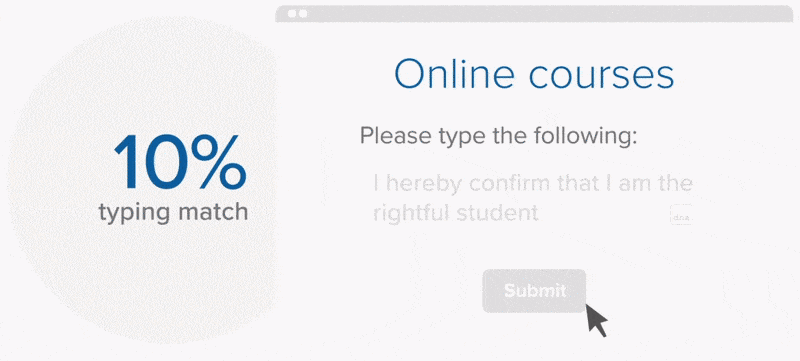Updated 2025
From K-12 schools to universities to continuous education platforms, learning providers all over the world are increasingly making their services available onlineYet academic dishonesty—especially in remote settings—remains a major threat to the integrity of degrees and certifications.
This blog post explains how institutions can safeguard academic integrity by validating students’ identities with keystroke dynamics, a behavioral biometrics technology that works seamlessly in remote environments.
The need for proctoring
Believe it or not, more than 70% of all test takers admitted to having cheated at one point in their academic careers. As such, making sure that the student doing the work is actually the one registered in the course is the first step institutions can take to lower the likelihood of rampant academic misconduct and dishonesty among students.
For both face-to-face and remote learning and examination programs, the introduction of proctoring and identity validation methods is crucial in order to authenticate the identities of online students and to ensure students take exams without cheating.
Student identity validation (a.k.a. authentication)
Traditional identity proofing uses webcams and student ID photos, such as passports or driver’s licenses. However, less intrusive options—like behavioral biometrics—analyze how students interact with their devices to confirm identity, without requiring video surveillance.
In-person versus remote proctoring
In-person human invigilators are required to ensure the security of an examination during face-to-face evaluations.
Despite the prevalence of testing and live-proctoring centers such as Pearson and Prometic, where students complete exams under the close scrutiny of an invigilator, the rise of online learning has made it nearly impossible for proctors to personally monitor every student taking an exam. Also, commercial testing centers are very expensive, and they take time to get to, which can inconvenience students.
Remote proctoring is necessary, but live invigilation via webcam introduces logistical and ethical issues.
Challenges of online human proctoring
- Human error, regardless of training and oversight
- Limited capacity (a human proctor can only watch 6–8 students at once)
- Poor scalability across thousands or millions of exams
- Student wait time during proctor connection and system checks
- Technical issues with bandwidth and system availability
Automated proctoring
Rather than dilute assessment standards by removing exams, institutions can adopt AI-driven proctoring, and automated proctoring systems to handle monitoring at scale.
AI-based proctoring runs throughout the exam, flagging suspicious behaviors for later review. It provides:
- Scalability, supporting thousands of exams with minimal human oversight
- Accessibility, enabling broader participation in online education
- Affordability, helping institutions compete globally while keeping costs down
Student identity validation with keystroke dynamics
Typing biometrics, or keystroke dynamics, analyzes the timing of key presses as a student types a short phrase. It’s one of the most accessible forms of biometrics—no special hardware, cameras, or microphones needed.
TypingDNA’s Authentication API, for instance, allows seamless authentication through any standard keyboard, using less than 1KB per pattern and supporting even low-bandwidth environments. It even supports mobile phones achieving impressive results on very short texts using typing-related telemetry data from mobile devices.
To explore how this integrates with LMS and exam systems, reach out to our team or visit the product page at https://www.typingdna.com/authentication-api.html.
